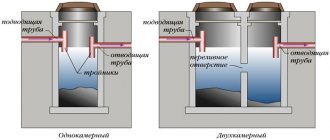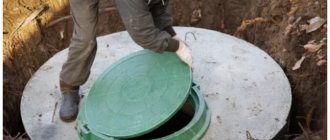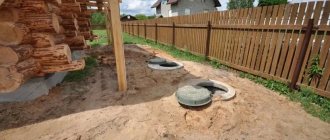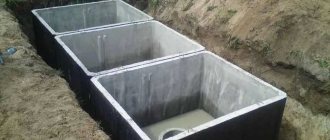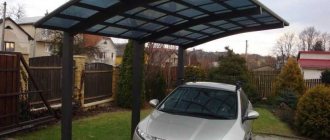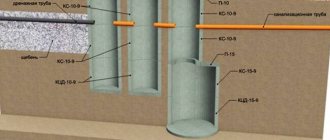In suburbs and cottage villages, central sewerage is extremely rare. Not to mention dacha cooperatives and villages. But this does not mean that their residents are deprived of basic amenities - it’s just that waste disposal takes place differently. There are several types of storage and treatment facilities. One of the most common local treatment systems is sewerage made from concrete rings.
One of the simplest and most popular wastewater treatment schemes is a two-chamber septic tank made of concrete rings with a filter well Source pochtidoma.ru
Features and advantages of concrete rings
The choice of materials for constructing containers, the main elements of an autonomous sewage system, is large: brick, metal, plastic, monolithic reinforced concrete, concrete rings.
Ordinary ceramic brick is used for these purposes if it remains in excess after construction. Its porous structure, hygroscopicity (water absorption of at least 8%) and the presence of a large number of masonry joints require comprehensive internal and external waterproofing of the tank using coating and roll materials to prevent groundwater from seeping in and wastewater from leaking out.
Metal containers can be used with a reservation - only in anaerobic septic tanks, when the flow of oxygen inside is limited by the design and principle of operation. In aerobic septic tanks in a humid, aggressive environment with forced air injection, the walls, and especially the welds, will quickly rust.
Plastic containers have virtually no disadvantages. But there are restrictions on use - they are “light”, and even when filled with wastewater, they will remain lighter than denser soil. When exposed to soil heaving forces, they can be literally squeezed out to the surface if they are not secured to a reinforced concrete slab installed as the base.
If the plastic septic tank is not secured, then heaving forces can very soon squeeze the container to the surface Source mirhat.ru
It is also advisable to strengthen the walls of the pit and provide a protective structure for the tank so that it takes loads from above.
Pouring monolithic reinforced concrete into formwork and its maturation takes a long time, significantly increasing the time from the start of construction to the commissioning of the sewerage system
Sewerage for a private house from concrete rings is built quickly, the design of the tanks has high rigidity and strength, and construction costs are low. And the reliability and durability of this material is evidenced by the fact that the main components of the central sewerage treatment facilities are made of precast reinforced concrete.
Disadvantages of SRC
- Great care is required when installing the well structure. No distortion is allowed. Otherwise, there is a high probability that the ring will burst (and it’s good if it is the top part, otherwise you will have to spend a lot of time dismantling the already mounted elements).
- The large weight of the well rings is also considered one of its disadvantages. For example, one product with a diameter of 1.0 meter weighs about 600 kilograms. That is why loading/unloading and installation will most likely require special equipment.
Sewage schemes made of concrete rings
Sewerage from concrete rings is made according to different schemes. The specific type depends on the seasonality of residence, intensity of operation, financial capabilities for purchasing additional equipment and paying operating costs.
The following options can be distinguished:
- Storage septic tank. Behind this name lies an ordinary cesspool with a waterproof bottom and walls. Tightness is a mandatory requirement, failure to comply with which, according to the administrative code of the Russian Federation, is regarded as damage to the land. When the wastewater fills the container, a sewage disposal truck is called.
A storage septic tank is simply a container into which wastewater is collected Source pinterest.pt
The smaller the capacity and the higher the intensity of operation of the points connected to the sewer, the more often you need to call the car. This is often how country sewer systems are constructed from concrete rings.
Note! The term “septic tank” in this case is not used entirely correctly, since by definition it is a treatment facility with waste flowing from chamber to chamber.
- Anaerobic septic tank. Two-, less often single-chamber, septic tanks, in sealed containers of which wastewater is purified by anaerobic bacteria (without access to oxygen). The number of chambers and their volume are chosen so that at the exit of the septic tank the wastewater is purified by 65-75%. Post-treatment occurs in filtration wells (“without bottom”), trenches or fields with aerobic bacteria (it is called “biological treatment”). Only after this can wastewater be discharged into the ground. The scheme is very popular among owners of country houses and dachas due to the simplicity of the device and energy independence. The disadvantage of the scheme is that it is necessary to periodically change the sand and crushed stone in the filter structures, in which case they have to be opened and the used material must be disposed of (although this is done infrequently).
Diagram of an anaerobic septic tank made of reinforced concrete rings Source o-cemente.info
See also: Catalog of companies that specialize in water supply and sewerage.
- Aerobic septic tanks and biological treatment stations. There is also a phase of primary accumulation and partial processing of feces with the help of anaerobic bacteria. The principle of operation is the clarification of wastewater in the absence of oxygen, and additional purification in the last chamber by aerobic bacteria under conditions of forced air injection. The purity of the wastewater at the outlet is considered to be 95-98%, and it can be discharged into the ground or used for irrigation. Disadvantage: aerobic bacteria die if the air supply compressor does not work. And this happens when the network is poor due to power outages.
The operating principle of aerobic septic tanks is that electricity is required for operation. Source prostroyer.ru
Volumes of septic tanks, dimensions of concrete rings, bottoms and ceilings
The total volume of the septic tank is determined as the three-day water requirement at the rate of 200 liters per person. The filter well is not included in this calculation.
Note! It is believed that the cycle of separation and purification of wastewater is 72 hours.
For a single-chamber septic tank, the entire volume falls on the first chamber; for a two-chamber septic tank, the containers are usually divided in the ratio of 2/3 and 1/3. Although many “simplify” the circuit and make both containers the same, in this case the first of them must be no less than 2/3 of the calculated volume.
Knowing the volume of the septic tank, you can choose the optimal dimensions from the standard range of KS wall rings in accordance with GOST 8020-90.
Typically, sewer rings are selected from the KS15 or KS20 range.
KS7 is used as a well neck (when needed).
KS10 has a volume of 0.24 m3 with a maximum ring height of 89 cm. Three elements of the first tank of a two-chamber septic tank will only be enough for wastewater from the life of one person. They can be used in a two-chamber or three-chamber septic tank scheme as rings for the second and third tanks, if the family consists of no more than three people.
Concrete rings KS can be selected for any septic tank Source rinnipool.ru
Waterproofing outside
To prevent precipitation from penetrating into the well water and spoiling it, it is necessary to make external insulation of the well. We will use dense clay as a sealant.
Around the last (upper) concrete ring of the well, we dig a trench 50-70 m wide and about 1-2 m deep. We fill this space with clay so that it forms a slope from the walls of the ring (at the top point) down and to the sides. We compact the clay well and form a kind of house.
The finished well should be completely pumped out several times. After this, the liquid can be taken to the laboratory for analysis. You can drink it only after an expert opinion. At this point, the installation of the well can be considered complete.
Choosing a location for a septic tank, installing a filter well
The choice of location for the septic tank is carried out taking into account regulatory requirements (5 m from the house, 30-50 meters from the water intake or reservoir). The second criterion is service. Although septic tanks do not require frequent pumping like cesspools, the containers must be freed from solid sediments - otherwise they will form a large layer of “mineral” deposits at the bottom, and this will reduce the performance of the treatment system.
When biologically purifying wastewater in wells or fields, it must be taken into account that they are installed in soils with good filtering properties - sand and sandy loam.
Restrictions when installing septic tanks Source 1beton.info
For low-filtration soils, filter trenches are installed after the septic tank to collect water in storage tanks for irrigation or discharge into a nearby body of water.
If, based on the geological features of the site, a scheme with trenches and filtration fields is chosen, then it must be taken into account that only a lawn can be laid out on their area or small shrubs with a shallow root system can be planted.
Sewerage from rings Source pinterest.com
The filter well does not have a sealed bottom - instead, it is backfilled with a mixture of gravel (crushed stone) with screenings or coarse sand. The height of the backfill is about 30 cm. They no longer do it due to difficulties during subsequent replacement.
The rest of the load for filtering treated waste is taken up by the backfill around the “perforated” walls of the well. The recommended layer thickness is 30 cm. Perforation of the walls should start from the bottom and end at the level of the pipe entrance from the overflow of the last chamber of the septic tank. For the walls, either ordinary well rings are used, in the walls of which, before installation, holes with a diameter of 3-6 cm are made (with a total area of at least 10% of the total), or special perforated rings for drainage wells are installed.
Construction of the structure
It is most convenient to carry out work at the end of summer. The rings can be lowered into an already dug hole or gradually during the digging process. The digging method depends on the type of soil and terrain characteristics. For resistant rocks, a pit is made using the open method.
Stages of constructing a structure using the open method:
- Digging a hole until an aquifer appears. In this case, the diameter of the recess should be 20-30 cm larger than the rings.
- Deepening the rings into the shaft. In this case, a winch is used.
- The distance between the rings and the pit is filled with sand; crushed stone can also be used. Seams require sealing.
It is best to carry out work on constructing a well at the end of summer.
On fragile terrain, a closed construction method is used. First, 2 m of the top layer should be removed. Then the first ring is lowered. Further work is carried out inside it.
To equip a well, reinforced concrete rings measuring 100-150 cm in diameter and 40 to 90 cm in length are used.
When deepening the first ring, the rest are gradually applied. This increases the pressure on the ground, and the elements sink lower. When they reach the aquifer, the last ring is installed. The pace of construction is quite fast if you use concrete rings.
When the aquifer is reached, digging is continued until the intensity of water presence increases. The number of cores must be at least 3. When the mission is completed, the work is stopped and resumed the next day.
Next, the liquid is pumped out of the well, and a filter is installed at the bottom. For this, crushed stone, large stones, and geotextile pads are used. It is important not to clog the veins. The height of such a pillow is kept within 30-40 cm. After this work, wait until the mine is filled with water. When the level rises by 150 cm, pipe connections can be installed.
Installation features
The sewer rings are installed on the bottom slab, which acts as a slab foundation. A prefabricated reinforced concrete structure must have a stable and reliable foundation. Here you also need to prepare the bottom of the pit: leveling, compacting, backfilling with a layer of sand and crushed stone.
During installation, it is necessary to seal the seams with cement mortar, followed by treating the entire surface with waterproofing compounds.
Advice! You can choose rings “with a quarter” - profiled ends. They provide a more reliable connection in terms of joining accuracy, structural strength, and seam tightness.
The recommended height of wells is no more than three rings. If you make it higher, the structure will be “weaker”.
Stage of installation of sewerage in a private house made of concrete rings Source 1beton.info
The entrance hole to the first well is mounted no lower than 30 cm from the lid. And the overflow holes are made with a slight decrease. This leads to a decrease in the “working” volume of the septic tank, which must be taken into account when choosing ring sizes.
Purpose of wells
Various types of concrete ring structures are used in the construction of a number of objects, differing in their purpose for the following types of products:
- intended for installation of inspection type wells;
- for the installation of urban sewer systems and collectors;
- water intake wells;
- for equipment of wiring and protection systems for underground cable communications;
- for the construction of filter wells.

